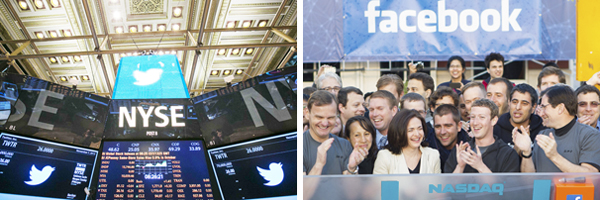Twitter still no match for Facebook

Left: The Twitter logo is displayed on screens prior to its IPO on the floor of the New York Stock Exchange in New York, Nov. 7, 2013. [REUTERS/NEWS1] , Right: Facebook founder, chairman and CEO, Mark Zuckerberg, center, applauds at the opening bell of the Nasdaq stock market, May 18, 2012, from Facebook headquarters in Menlo Park, California.[AP/NEWSIS]

Leonid Bershidsky
Officially, Twitter lost $144.6 million in the second quarter of this year. Normally, it wouldn’t do to trust gimmicky measures like adjusted Ebitda (earnings before interest, taxes, depreciation and amortization) or “adjusted net income” for a large public company. But Twitter is justified in touting these. The adjustments are not a gloss on the company’s operational performance. They mainly concern Twitter’s expenses for stock-based compensation, which reflects the care the company is taking to attract and retain top talent.
Had it not been for $158 million in stock-based compensation expenses in the last quarter, Twitter would have earned about $14 million, its biggest profit ever (although based on generally accepted accounting principles, it has never had a profitable quarter). For a company that only started monetizing its user base in 2009, and has had to hire rapidly, that’s not bad. It proves the platform can subsist on advertising and data licensing revenue even now.
Twitter’s revenue is growing much faster than expenses. In the second quarter, revenue was up 124 percent year-on-year, while expenses increased 94 percent (mostly because of hiring). The company is no longer burning money: The adjusted net income has been positive for the past three quarters. The microblog network is also rapidly correcting its geographical imbalances. Twitter has only 22 percent of its audience in the United States but makes 64 percent of its revenue there. However, international revenue increased 168 percent year-on-year in the second quarter, much faster than revenue for the company as a whole. The business model is viable and globally scalable. The service many of us have come to rely on for news will not wither on the vine.
For investors, the story is more complicated. Twitter’s earnings to sales are a fraction of Facebook’s. And according to data compiled by Bloomberg, Twitter had the highest predicted 2015 price-to-earnings ratio of its Internet industry peers even before Twitter’s share price rocketed an inexplicable 29 percent after the second-quarter results announcement. There’s a lot of long-term faith priced into the the company’s valuation.
It’s not clear what Twitter can do to justify that kind of faith. Facebook, with its 1.37 billion monthly active users, would need to make a lot of mistakes for Twitter, with 271 million, to catch it. That’s not likely to happen, if only because scale is now favoring Facebook: In the last quarter, it spent $0.95 per user, compared with Twitter’s $1.09.
It’s tough to be so far behind a powerful rival. An April report by marketing company Resolution showed that ads on Twitter were more effective than on Facebook, generating more clicks, but big advertisers such as Pepsi, McDonald’s, Hertz and FedEx still spent 127 percent more money with Facebook because ads there reached more users.
The phenomenon is known to anyone who has ever started a website or - in olden days - a print publication in a niche already populated by powerful competitors. Established leaders get a disproportionate share of the pie even if they are less effective vehicles for advertising than the runners-up. It’s sheer psychological inertia and risk aversion.
Twitter still has a comparative advantage over Facebook in mobile ads: They make up 81 percent of its ad revenue, compared with 62 percent for Facebook. Advertisers, however, will not be impressed: Facebook only started selling mobile ads two years ago. Now, only Google can rival it in mobile.
“We do not see any structural reasons that the levels of monetization for our monthly active users can’t reach or exceed that of our industry peers over time,” Twitter’s chief financial officer, Mike Gupta, said on the latest earnings call. Being a perpetual runner-up, however, is a structural reason, and Twitter is not doing anything to close the gap with Facebook. In absolute terms, Mark Zuckerberg’s company added 41 million users in the last quarter; Twitter signed up 16 million, its highest tally in five quarters.
There is no reason, then, for investors to give Twitter higher valuation ratios than they grant Facebook. The company is no dud, but it makes sense to modify expectations about its place in the industry.
*The author is a Berlin-based Bloomberg View contributor.
BY Leonid Bershidsky










with the Korea JoongAng Daily
To write comments, please log in to one of the accounts.
Standards Board Policy (0/250자)